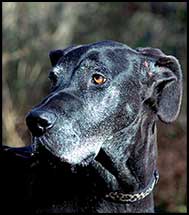

TALE
OF TWO CANCERS
– Dianne Powers –
It
was November, 2002, and Grace was almost seven. During a Christmas
card photo session, I
noted that Grace seemed a bit "off. I
attributed it at the time to her everlasting disdain for being dressed
up in hats for
pictures, as clearly seen in Not all Grinches
are Green. If you look closely
at the picture to the right, you can see that the lymph nodes in Grace's
groin were enlarged. 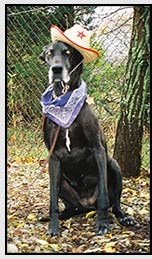 (I
simply thought she was looking a little chubby,
but vowed not to tell her.) Later that
day I noticed enlarged lymph nodes on her neck and in her armpits.
The next morning I called the vet, Dr. Connie Breese. She made time
for us that very same day. That was the first sign that we were in
trouble. (I
simply thought she was looking a little chubby,
but vowed not to tell her.) Later that
day I noticed enlarged lymph nodes on her neck and in her armpits.
The next morning I called the vet, Dr. Connie Breese. She made time
for us that very same day. That was the first sign that we were in
trouble.
Canine Lymphoma
Dr. Breese
took one look at Grace, who by then was walking stiffly
due
to the
swollen lymph nodes, and said it was probably lymphoma.
She felt that the quickest way to get a definitive diagnosis would
be to send Grace to Tufts. She made
a call
and four days later we found ourselves in an examining room at Tufts.
That's where my world came crashing down around me. Grace was positively
diagnosed with lymphoma.
Tufts Oncology
Grace's first appointment
with the oncology team at Tufts Oncology in North Grafton, MA, occurred
nine days later. We agreed on a course of treatment that would begin
with chemotherapy and conclude with an autologous bone marrow transplant.
Just
before Christmas, eighteen days after her initial diagnosis, Grace
received
her first
chemo treatment. The
protocol administered to Grace was the VELCAP Radiation Protocol, or
VC-RT. It's an aggressive 16-week chemotherapy
rotation that uses the following drugs: Prednisone, Vincristine, L-asparaginase,
Adriamycin, Cytoxan, Mustargen and Procarbazine. After six weeks of
VC-RT treatments, the protocol is "split" depending on whether
a dog's diagnosis is T-cell or B-cell
lymphoma. Grace had B-cell lymphoma (stage IIIa) so she
continued with the B-cell protocol for eight more weeks. The following
week (week
15) was a "rest week" which was followed by a week
of daily Neupogen injections in preparation for a bone marrow harvest.
Lymphoma
survival averages four to eight weeks with no treatment. With chemo
only, you can expect three to six months months of remission. With
chemo and a bone marrow transplant, two thirds of the patients can
expect to stay in remission for up to one year. One third stay in remission
longer.
|
|
 |
Bone Marrow Transplant
Neupogen
is a white blood cell booster and was administered to
stimulate Grace's white blood cell production prior to the bone marrow
harvest. The bone marrow harvest took place on week 17. This was followed
by another rest week. During week 19,
Grace received a large dose of Cytoxan followed by
Mesna
and Baytril. Forty eight hours later she received her bone marrow infusion.
Week 20, all she needed was blood work (CBC/platelet).
From that point
on, Grace had monthly check-ups that consisted of a physical exam and
blood work. She was "clean" every time. After a year (from date of
chemo start-up) she went for quarterly
check-ups.
Supplementary
Support
The chemo never made Grace very sick. Throughout all of the chemotherapy
treatments Grace had twice-monthly acupuncture treatments to support
her immune system. She also took daily doses of thymus, milk thistle
and a product called Cell Forte, a dietary supplement that is supposed
to enhance natural "killer cell" activity. I adjusted her diet by adding
more protein in the form of meat because I had read that cancer cells
thrive on carbohydrates.
 Cancer Free! Cancer Free!
On May 30, 2003, one month following her bone marrow transplant, Grace
was shown in the Veterans class at the Great Dane Club of New England
Independent Specialty. She looked lovely. What followed
were twelve months of bliss, enjoying every day we had together. We
had always had a strong bond, but this experience brought us to a different
level of connection and communication.
A "New" Cancer
In mid-May
of 2004, Grace developed an unexplained limp. Palpation and manipulation
of her leg showed no tenderness and no injury site. With
my heart in my mouth I called Dr. Breese and told her the symptoms.
Once again, she made time for us that day. We did an x-ray and it showed
nothing. Grace was given Rimadyl for ten days, which did not improve
her condition. By the end of two weeks Grace had gone from my "light
on her feet" girl to a dog who could hardly move.
We repeated
the x-rays and saw a change in the
bone structure that most likely meant osteosarcoma. Dr.
Breese and I discussed treatment options:
1) Do nothing
2) Palliative
radiation
3) Amputation and chemotherapy
Without amputation
and chemotherapy, Grace was given three months. With luck, she might
make it through
the summer. While I stewed over the options, Grace
was put on 150mg daily of Deramaxx. In addition
to the pain control
action of this drug, it appears to have tumor fighting
qualities. As with any drug, there are potential side effects to the
digestive system, kidneys or liver. Fortunately, Grace seemed to have
no problem with it. After three days on Deramaxx she was moving
well
again. Within a week, she was putting full weight on her leg and
running.
My final decision
was to do the palliative radiation, but nothing
further. At that time I felt it was not in Grace's best interest to
amputate. She was, afterall, a nine-year-old Dane who had already survived
one form of cancer. In
July she went to Tufts for palliative radiation, the first of a series
of three sessions.
Location of
the Tumor
At
the primary appointment her oncologist acknowledged something that
I had
already noted. The tumor was on the bone
marrow harvest site. Grace was the second dog known to Tufts
who had gone through the lymphoma protocol and bone marrow transplant
who later developed osteosarcoma at the harvest site. She was
asked to participate in a study, but it would mean weekly trips to
Tufts. After
much thought I decided that was not in Grace’s best interest.
She was always very stressed when we were there, and I didn't want
to put her through it. We went home to (hopefully)enjoy the rest of
the summer.
Meanwhile, Grace received
bi-monthly acupuncture which we upped to weekly in November. The hardest
part
of this whole
process for me was feeling as though I was doing nothing. At the end
of August, her limp began to be a bit more pronounced, although she
continued to run every chance she got.
Amputation?
I revisited
the amputation option and had her x-rayed to see if the cancer had
moved
to her lungs,
which is the usual progression. Her lungs were clear, but again I
decided that amputation
was not in her best interest. Her limp continued to worsen, but she
continued to defy it and enjoy life.
In November, though,
she really started to change. The dog who always wanted her space when
she was sleeping and had always slept in her own bed suddenly wanted
to
join
me on the "big bed." She was staying close by. The tumor was growing
again and Grace basically stopped using her leg. In January I reconsidered,
one more time, the idea of amputation. We went to
see an orthopedic surgeon who, coincidentally, has a three-legged
dog.
After examination and
a lengthy discussion which centered on the fact that
outwardly – other than the cancerous leg – Grace
was in incredible shape for a 9-year-old Great Dane, we agreed to
x-ray
her lungs. If
they were clear, perhaps we'd amputate. My desire at that time
was to take away her pain. It had become very clear that without
that leg, Grace would be much more comfortable, and for all intents
she was already a three-legged dog.
A Final Decision
Unfortunately
the cancer made the decision for me because it was in her lungs. The
next
three
weeks were
the shortest
and longest of my life. Grace began to go downhill very quickly, more
and more uncomfortable, but at the same time more and more resolved
to stick around. Ten days before I let her go, she had a seizure. Although
she appeared to come back fully, I believe now that the seizure was
the beginning of the end.
We let Grace go on
February 1, 2005, eleven days shy of her
tenth birthday. She went quietly, surrounded by love and with her favorite
music, "Amazing
Grace" in Navajo and Sioux.
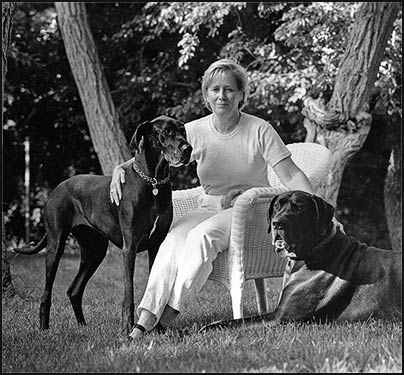
Grace, Dianne and Trouper

Grace's Legacy
I have
been thinking how much Grace changed my life. Without her, for me there
would have been no GDML (my first foray into special interest group
email), no DaDane, no GDCA National Specialties, no Great Dane Rescue,
no Great
Dane
Club of
America Affiliate Representative – not to mention the many
people I consider to be great friends. And the list could continue.
I have many silly thoughts – like the knowledge that Great
Dane's feet smell
like popcorn (maybe other dogs do as well, but it never occurred to
me to smell them), and just what the "zoomies" are. But perhaps most
importantly, Grace showed me how beautiful movement in a dog could
be.
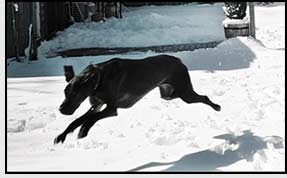 Grace
was one of the prettiest moving dogs I have ever seen. She had beautiful
extension and
drive, plus she was exquisitely graceful. I loved nothing more than
taking her to a big open field and unclipping the leash so I could
watch her
float in big circles, so beautiful and so happy. It took my breath
away. The hardest part of osteosarcoma for both of us was her losing
the ability to run like that. Grace
was one of the prettiest moving dogs I have ever seen. She had beautiful
extension and
drive, plus she was exquisitely graceful. I loved nothing more than
taking her to a big open field and unclipping the leash so I could
watch her
float in big circles, so beautiful and so happy. It took my breath
away. The hardest part of osteosarcoma for both of us was her losing
the ability to run like that.
I think about
Grace's attitude, which was so cleverly captured in Grinches.
She came by the nickname "Princess"
honestly
and lived by it till her last breath. She taught me about alternative
therapies and opened my mind to the possibility of communication – she
certainly knew how to communicate her wishes to me. She taught me about
cancer (two kinds, at that) and I learned that i shouldn't believe
everything I read or everything that is expected (like the fact that
she should
not have made it past the summer). Grace had such a strong drive to
live. Her vet's favorite comment about Grace, and she made the comment
many
times over the past couple years, was that "Grace obviously hasn't
read the book" – meaning that she had no idea that
clinically she was not supposed to be alive.
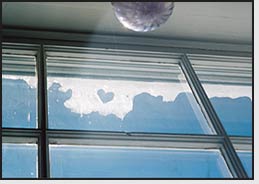 Her
final life lesson to me was in seeing when it was time to let her go.
Selfishly I wish
I could have ignored
that lesson, but she was not to be ignored. <G> I know in my
heart that she is free now and running like the wind again. I believe
she
sent me a sign the day she passed. I was sitting on the couch and happened
to look out my window. There was an ice overhang on my roof that was
melting in the sun. In the middle of that overhang was a heart. Ten
minutes later it was gone, melted away. What made me look out the window
at that exact time, and what drew my eye to the overhang? I'd like
to believe
it was Grace letting me and Trouper know she was fine. Her
final life lesson to me was in seeing when it was time to let her go.
Selfishly I wish
I could have ignored
that lesson, but she was not to be ignored. <G> I know in my
heart that she is free now and running like the wind again. I believe
she
sent me a sign the day she passed. I was sitting on the couch and happened
to look out my window. There was an ice overhang on my roof that was
melting in the sun. In the middle of that overhang was a heart. Ten
minutes later it was gone, melted away. What made me look out the window
at that exact time, and what drew my eye to the overhang? I'd like
to believe
it was Grace letting me and Trouper know she was fine.
— Dianne Powers |

![]()




 (I
simply thought she was looking a little chubby,
but vowed not to tell her.) Later that
day I noticed enlarged lymph nodes on her neck and in her armpits.
The next morning I called the vet, Dr. Connie Breese. She made time
for us that very same day. That was the first sign that we were in
trouble.
(I
simply thought she was looking a little chubby,
but vowed not to tell her.) Later that
day I noticed enlarged lymph nodes on her neck and in her armpits.
The next morning I called the vet, Dr. Connie Breese. She made time
for us that very same day. That was the first sign that we were in
trouble.  Cancer Free!
Cancer Free!
 Grace
was one of the prettiest moving dogs I have ever seen. She had beautiful
extension and
drive, plus she was exquisitely graceful. I loved nothing more than
taking her to a big open field and unclipping the leash so I could
watch her
float in big circles, so beautiful and so happy. It took my breath
away. The hardest part of osteosarcoma for both of us was her losing
the ability to run like that.
Grace
was one of the prettiest moving dogs I have ever seen. She had beautiful
extension and
drive, plus she was exquisitely graceful. I loved nothing more than
taking her to a big open field and unclipping the leash so I could
watch her
float in big circles, so beautiful and so happy. It took my breath
away. The hardest part of osteosarcoma for both of us was her losing
the ability to run like that. Her
final life lesson to me was in seeing when it was time to let her go.
Selfishly I wish
I could have ignored
that lesson, but she was not to be ignored. <G> I know in my
heart that she is free now and running like the wind again. I believe
she
sent me a sign the day she passed. I was sitting on the couch and happened
to look out my window. There was an ice overhang on my roof that was
melting in the sun. In the middle of that overhang was a heart. Ten
minutes later it was gone, melted away. What made me look out the window
at that exact time, and what drew my eye to the overhang? I'd like
to believe
it was Grace letting me and Trouper know she was fine.
Her
final life lesson to me was in seeing when it was time to let her go.
Selfishly I wish
I could have ignored
that lesson, but she was not to be ignored. <G> I know in my
heart that she is free now and running like the wind again. I believe
she
sent me a sign the day she passed. I was sitting on the couch and happened
to look out my window. There was an ice overhang on my roof that was
melting in the sun. In the middle of that overhang was a heart. Ten
minutes later it was gone, melted away. What made me look out the window
at that exact time, and what drew my eye to the overhang? I'd like
to believe
it was Grace letting me and Trouper know she was fine.